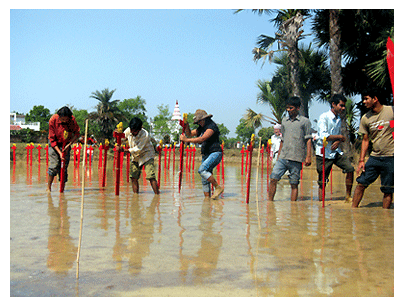- Prelude
- Editorial
- A Conversation with Sheela Gowda
- The DIY Artist with a Mission
- Discovering Novel Horizons
- A Conversation with Raqs Media Collective
- Manjunath Kamath
- Jitish Kallat- the Alchemist
- The Artist and the Dangers of the Everyday: Medium, Perception and Meaning in Shilpa Gupta's work
- An Attitude for the Indian New Media
- Weave a Dream-Theme Over Air or a Medium like Ether
- Installation in Perspective: Two Outdoor Projects
- Towards The Future: New Media Practice at Kala Bhavana
- Workshop @ Facebook
- Desire Machine: Creating Their Own Moments…
- Typography: The Art of Playing with Words
- Legend of a Maverick
- Dunhill-Namiki
- The Period of Transition: William and Mary Style
- The Beauty of Stone
- Nero's Guests: Voicing Protest Against Peasant's Suicides
- Patrons and Artists
- The Dragon Masters
- What Happened and What's Forthcoming
- Art Chennai
- Art Events Kolkata
- Winds of Change
- Art Bengaluru
- Mumbai Art Sighting
- Musings from Chennai
- In the News
- Previews
- Ascending Energy, Merging Forms: Works by Satish Gujral
- Re-visiting the Root
- The Presence of Past a New Media Workshop
- Taue Project
ART news & views
Taue Project
Volume: 3 Issue No: 15 Month: 4 Year: 2011
by Mohammed Noman Ammouri
The Japanese artist Setsu Suzuki who introduces himself as a sculptor, through his work takes into account our society broadly. He considers (carves), analyses (chops) and reorganizes (joins) the world's materials through his drawings, performances and installations. His process is like that of an operation; he carves, chops and reassembles materials in order to contemplate society's merits and demerits through artistic interventions. Through the supposed act of an operation, he attempts to find the problems of today's established society, and tries to offer a solution to them. More specifically, he is looking at the impact of modernization on agrarian societies.
We had the opportunity to see his practice firsthand when he came down to Santiniketan to work on his international TAUE PROJECT. This project originally started in Japan in 1997, and gives a message for communication with different classes of society and to rediscover the origin of Japanese traditional culture. Through this work, Suzuki started to question the relationships between reality and art, art and the earth, and the earth and human beings thirteen years ago in a rice field in Yachiyo, his native place. Later, TAUE PROJECT travelled to Bangladesh, where the first site of installation was under the aegis of the Faculty of Fine Arts, University of Dhaka. The second site there was at Jhinaidah in a rice field in Sherpur, Shailkupa. The Santiniketan leg of this project, TAUE PROJECT 11, was inaugurated on 1st March 2011, at the Santiniketan Society of Visual Art and Design (SSVAD). The event was inaugurated by the artists K G Subramanyan and Jogen Chowdhury. It was made possible through the efforts of Saito Mitsuko and Mitsuko Karsawa (Japan), Nisar Hossain and Sheikh Afzal (Bangladesh) and Kala Bhavana, Santiniketan.
Nisar Hossain and Sheikh Afzal (Bangladesh) and Kala Bhavana, Santiniketan.
The group of drawings on display were titled NO-MEN, a very interesting title, since the word 'NO' in Japanese is homophonic owing to its multiple meanings. First, Suzuki says 'NO' to the absurdity of the human world. Second, the sound 'NO' also represents traditional art because 'NO-h' is the traditional art of Japan. Third, life originates from vegetation and is represented as 'NO-u', meaning farming in Japanese. And finally, brain holds enormous potentialities and is represented as 'NO', meaning brain in Japanese. He expresses society's problems by using the sound “NO”. Suzuki's sculptural works are called RAKAN, painted red sticks topped by unique sculpted faces which at first looked like the Noh mask, and later transformed into the faces of strict disciplinants. The RAKAN are planted in the rice fields. The drawings on paper originate from the element of RAKAN. The video installation on TAUE PROJECT was projected with the performance by the artist MAKO, who represented the “Shera-Sagi” (Bird) in her performance with a traditional mask which resembles the Noh mask.
The sculptural installation along with MAKO's open air performance was carried out in the rice field beside SSVAD, Sonajhuripalli. The professors and students of Kala Bhavana took part in the project by planting the RAKAN. Bengal's traditional Santhali dancers accompanied MAKO in the performance.
Suzuki says he brought the TAUE PROJECT to Bengal, since this is a place of harvest that has the mighty Ganga River running through both Bangladesh and India. Japan and Bengal are deeply linked by the proud culture of rice cultivation, so it was natural that the project addresses the concerns of the agrarian society in Bengal.
The view of the silent presence of rice fields filled with water before planting rice, the freshness of geometric patterns of new green leaves that spread as rice grows, provided most Japanese people with the solace of a mental home. As the society became modernised rapidly, particularly in the times of the war, these mental homes were in trouble. Tagore had warned about Japan's materialistic Europeanization before the pre-war periods. It is this concern that Suzuki addresses through his work.
Suzuki has realised the TAUE PROJECT five times all over Japan and shall wind up this project with an art exhibition in Japan.